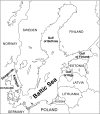PCB residues in the tissues of sea ducks wintering on the south coast of the Baltic Sea, Poland
- PMID: 30796664
- PMCID: PMC6469621
- DOI: 10.1007/s11356-019-04586-4
PCB residues in the tissues of sea ducks wintering on the south coast of the Baltic Sea, Poland
Abstract
The Baltic Sea is known to be severely polluted by a range of chemicals, one group of which being PCBs. Although the use and production of PCBs were limited or banned in many countries in the 1970s, their presence is still observed in the environment. The aim of this study was to evaluate PCBs concentration in four species of diving sea ducks, interspecies and tissues differences, and in the case of game species, comparison of the obtained results with maximal residue levels (MRLs) and tolerable weekly intake (TWI). The level of Σi-PCBs was noted in most examined samples (liver, muscle, fat tissue) at levels ranging between < LoD and 2315.45 ng/g lw. The dominant congener was PCB 153, followed by PCB 180 and 138. The mean dl-PCB-TEQ value in the muscles of the tested tufted ducks and common pochards was 0.31 and 0.71 pg-TEQ/g lw, respectively, which is 8-25 and 18-57% of the TEQ maximum limit (ML) value for farm animal muscles. The average decrease in i-ΣPCB concentration in the fat tissue of ducks wintering in the Baltic Sea southern coast was found to be 2.9-3.3%/year. The analysis of PCB residues indicates that the common pochard and tufted duck are not suitable for consumption due to high Σi-PCB concentrations. However, the regular consumption of muscle and liver of game birds does not result in an unacceptable intake of dl-PCBs, i.e., above the TWI value.
Keywords: Baltic Sea; Biomonitoring; PCBs; Sea ducks; TEQ.
Figures
Similar articles
-
Dioxins and PCBs in game animals: Interspecies comparison and related consumer exposure.Environ Int. 2016 Apr-May;89-90:21-9. doi: 10.1016/j.envint.2016.01.007. Epub 2016 Jan 27. Environ Int. 2016. PMID: 26826359
-
Chlorinated hydrocarbons in diving ducks wintering in Gdańsk Bay, Baltic Sea.Sci Total Environ. 1982 Jun;24(2):119-27. doi: 10.1016/0048-9697(82)90104-8. Sci Total Environ. 1982. PMID: 7112094
-
PCDD/Fs and DL-PCBs intake from fish caught in Polish fishing grounds in the Baltic Sea--characterizing the risk for consumers.Environ Int. 2013 Jun;56:32-41. doi: 10.1016/j.envint.2013.03.002. Epub 2013 Apr 16. Environ Int. 2013. PMID: 23567327
-
Congener-specific data of polychlorinated biphenyl residues in human adipose tissue in Poland.Sci Total Environ. 1994 Jun 13;149(1-2):113-9. doi: 10.1016/0048-9697(94)90009-4. Sci Total Environ. 1994. PMID: 8029709
-
Dioxins and PCBs in feed and food--review from European perspective.Sci Total Environ. 2014 Sep 1;491-492:2-10. doi: 10.1016/j.scitotenv.2014.03.022. Epub 2014 May 5. Sci Total Environ. 2014. PMID: 24804623 Review.
Cited by
-
Energetic Compounds in the Trophic Chain—A Pilot Study Examining the Exposure Risk of Common Eiders (Somateria mollissima) to TNT, Its Metabolites, and By-Products.Toxics. 2022 Nov 12;10(11):685. doi: 10.3390/toxics10110685. Toxics. 2022. PMID: 36422895 Free PMC article.
-
An aggregation-induced emission immunoassay for broad detection of polychlorinated biphenyls in chicken and crab.Anal Bioanal Chem. 2022 Jul;414(17):4963-4975. doi: 10.1007/s00216-022-04123-2. Epub 2022 May 24. Anal Bioanal Chem. 2022. PMID: 35606453
-
PCB-77 biodegradation potential of biosurfactant producing bacterial isolates recovered from contaminated soil.Front Microbiol. 2022 Sep 26;13:952374. doi: 10.3389/fmicb.2022.952374. eCollection 2022. Front Microbiol. 2022. PMID: 36225351 Free PMC article.
-
Endocrine-disrupting organochlorine xenobiotics in fish products imported from Asia-an assessment of human health risk.Environ Monit Assess. 2021 Feb 16;193(3):132. doi: 10.1007/s10661-021-08914-5. Environ Monit Assess. 2021. PMID: 33590385 Free PMC article.
References
-
- Barron MG, Galbraith H, Beltman D. Comparative reproductive and developmental toxicology of PCBs in birds. Comp Biochem Physiol. 1995;112C(1):1–14.
-
- Bignert A, Danielsson S, Strandmark A, Nyberg E, Asplund L, Eriksson U, Berger U, Wilander A. Haglund P (2008) Comments concerning the national Swedish contaminant monitoring programme in marine biota, 2008. Swedish Museum of Natural History, Stockholm, pp 142
MeSH terms
Substances
LinkOut - more resources
Full Text Sources




